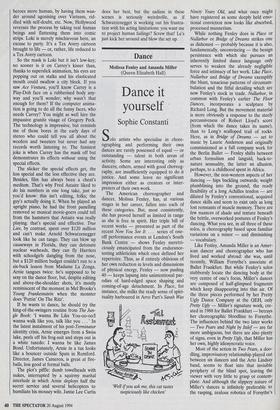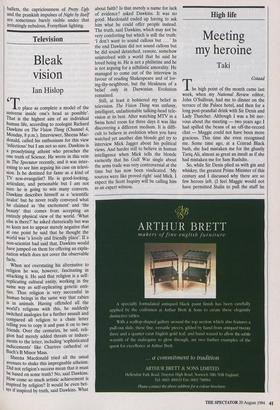Dance
Dance it yourself
Sophie Constanti
Solo artists who specialise in chore- ographing and performing their own dances are rarely possessed of equal — or outstanding — talent in both areas of activity. Some are interesting only as dancers; others, armed with good choreog- raphy, are insufficiently equipped to do it justice. And some leave no significant impression either as creators or inter- preters of their own work.
The American choreographer and dancer, Molissa Fenley, has, at various stages in her career, fallen into each of these categories. But, most consistently, she has proved herself as limited in range as she is free in spirit. Her triple bill of recent works — presented as part of the recent Now You See It . . . series of one- off performance events at London's South Bank Centre — shows Fenley meretri- ciously emancipated from the endurance- testing athleticism which once defined her repertoire. Thus, as if entirely oblivious of her own reduction in levels and dimensions of physical energy, Fenley — now pushng 40 — keeps lapsing into unintentional par- odies of hard-edged space shaping and coming-of-age detachment. In Place, for instance, she milks the ready sense of spiri- tuality harboured in Arvo Part's Sarah Was Well ifyou ask me, this cat tastes suspiciously like chicken' Ninety Years Old, and what once might have registered as some deeply held emo- tional conviction now looks like absorbed, processed mannerism.
While nothing Fenley does in Place or Nullarbor or Bridge of Dreams strikes one as dishonest — probably because it is also, fundamentally, unconvincing — the benign persistence with which she pursues an inherently limited dance language only serves to weaken the already negligible force and intimacy of her work. Like Place, Nullarbor and Bridge of Dreams exemplify the blunt, tenacious patterns of circumam- bulation and the fitful detailing which are now Fenley's stock in trade. Nullarbor, in common with Fenley's earlier The Floor Dances, incorporates a sculpture by Richard Long. But the movement material is more obviously a response to the steely percussiveness of Robert Lloyd's score (from which the dance takes its name), than to Long's scalloped trail of rocks. Here, as in Bridge of Dreams — set to music by Laurie Anderson and originally commissioned as a full company work for the Berlin Ballet — Fenley shifts between urban formulism and languid, back-to- nature sensuality, the latter an allusion, perhaps, to a childhood spent in Africa.
However, the non-western aspects of her dancing — hips buckling outwards; weight plumblining into the ground; the ready flexibility of a long Achilles tendon — are diluted by Fenley's conventional, acquired dance skills and seem to exist only as long lost remnants of muscle memory. There are few nuances of shade and texture beneath the brittle, overworked postures of Fenley's dancing. What you see, in all three of these solos, is choreography based upon familiar variations on a minor — and diminishing — vocabulary.
Like Fenley, Amanda Miller is an Amer- ican dancer and choreographer who has lived and worked abroad: she was, until recently, William Forsythe's associate at Ballet Frankfurt. But while Fenley's solos stubbornly locate the dancing body at the very centre of one's focus, Miller's dances are composed of half-glimpsed fragments which keep disappearing into thin air. Of the three pieces performed by her Pretty Ugly Dance Company at the QEH, only Pretty Ugly — Miller's signature work, cre- ated in 1988 for Ballet Frankfurt — betrays her choreographic bloodline to Forsythe. The influences behind the two later works — Two Pears and Night by Itslef — are far more ambiguous, but there are also plenty of signs, even in Pretty Ugly, that Miller has her own, highly idiosyncratic voice.
Most of the action in Two Pears, a doo- dling, improvisatory relationship played out between six dancers and the Arto Lindsay band, seems to float into that invisible periphery of the blind spot, leaving the viewer with very little to grasp or contem- plate. And although the slippery nature of Miller's dances is infinitely preferable to the rasping, zealous robotics of Forsythe's ballets, the capriciousness of Pretty Ugly and the prankish impulses of Night by Itself are sometimes barely visible under that irritatingly nebulous, Forsythian lighting.



















































 Previous page
Previous page